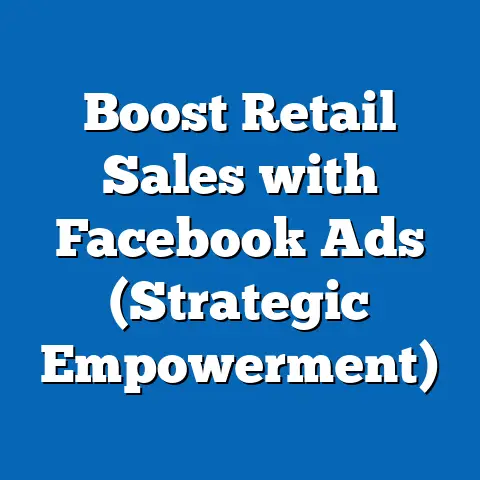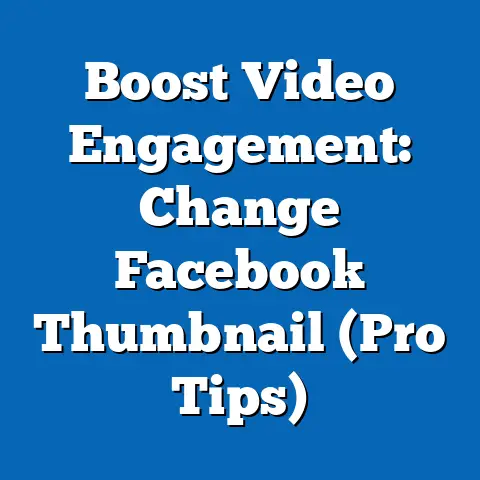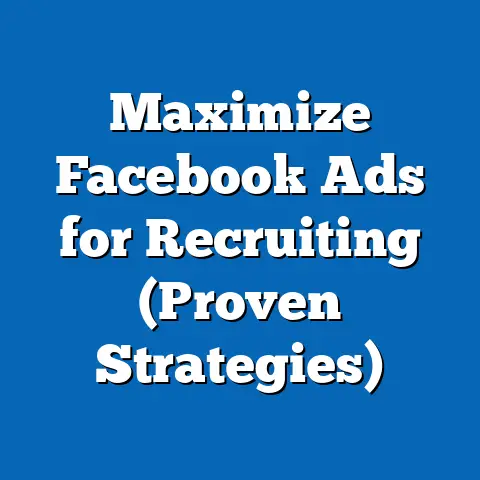Tackling Facebook Ad Discrimination (Essential Solutions)
Facebook advertising offers an unparalleled opportunity to reach billions of potential customers. As someone who has spent years navigating the ever-evolving landscape of digital marketing, I’ve seen firsthand how powerful these tools can be. But with great power comes great responsibility. The ability to precisely target audiences can also be misused, leading to discriminatory practices that not only harm individuals and communities but also undermine a business’s long-term success.
Imagine launching a campaign, excited about the potential reach, only to discover later that your ads were inadvertently excluding certain demographics. This isn’t just a hypothetical scenario; it’s a reality for many businesses, often without them even realizing it. The “resale value” of your advertising efforts, in this context, isn’t about flipping ads for profit; it’s about building a brand that resonates with a diverse audience, fostering loyalty, and ultimately, achieving sustainable growth.
Discrimination in Facebook ads diminishes this “resale value” in several ways. It limits your market reach, alienates potential customers, and damages your brand’s reputation. Moreover, it opens you up to legal challenges and regulatory scrutiny. This article isn’t just about avoiding legal pitfalls; it’s about building a better, more inclusive, and ultimately more profitable business.
We’ll delve into the nuances of Facebook ad discrimination, explore the legal framework surrounding it, and examine the tangible impact it can have on your bottom line. More importantly, I’ll provide actionable solutions that you can implement today to create a more equitable and effective advertising strategy. Let’s embark on this journey together, ensuring that your Facebook ads contribute to a more inclusive world while simultaneously driving business success.
Understanding Facebook Ad Discrimination
Discrimination in Facebook advertising is a complex issue that goes beyond overt, intentional bias. It encompasses any practice that disproportionately excludes or negatively impacts individuals based on protected characteristics such as race, ethnicity, gender, religion, age, disability, or sexual orientation. As someone who’s been in the trenches of digital advertising, I’ve seen firsthand how seemingly innocuous targeting choices can inadvertently lead to discriminatory outcomes.
Defining Discrimination in Facebook Advertising
Here’s a breakdown of how discrimination can manifest itself on the platform:
- Targeting Exclusions: This is perhaps the most obvious form of discrimination. It involves explicitly excluding certain demographic groups from seeing your ads. For example, targeting housing ads only to specific zip codes known to have predominantly white populations.
- Algorithmic Bias: Facebook’s algorithms, while designed to optimize ad delivery, can sometimes perpetuate existing societal biases. If the algorithm learns that certain demographics are less likely to convert on a particular type of ad, it might prioritize showing the ad to other groups, even if there’s no explicit exclusion.
- Interest-Based Targeting: While seemingly neutral, interest-based targeting can also lead to discriminatory outcomes if certain interests are disproportionately associated with specific demographic groups. For instance, targeting ads for high-end financial services only to users interested in “golf” or “yachting” might inadvertently exclude lower-income individuals and minority groups.
- Lookalike Audiences: Creating lookalike audiences based on existing customer data can also introduce bias if the original customer base is not representative of the broader population.
- Ad Content: The content of your ads itself can be discriminatory, even if the targeting is not. For example, using imagery that exclusively features one racial group can alienate potential customers from other groups.
Implications of Discrimination
The implications of Facebook ad discrimination are far-reaching, affecting both users and businesses:
- Psychological Impact on Marginalized Groups: Being excluded from seeing certain ads can reinforce feelings of marginalization and exclusion, contributing to systemic inequality. Imagine constantly being shown ads for low-paying jobs or predatory lending services, while being excluded from ads for higher education or homeownership. This can have a profound impact on self-esteem and opportunities.
- Legal Ramifications for Businesses: Engaging in discriminatory advertising practices can lead to legal challenges, regulatory investigations, and hefty fines. The Department of Housing and Urban Development (HUD), for example, has taken action against Facebook for discriminatory housing ads.
- Damage to Brand Reputation: In today’s socially conscious environment, consumers are increasingly aware of and concerned about issues of diversity and inclusion. Being perceived as discriminatory can severely damage your brand’s reputation and erode customer trust.
- Limited Market Reach: By excluding certain demographic groups, you’re effectively limiting your potential customer base and missing out on valuable revenue opportunities.
- Perpetuation of Inequality: Discriminatory advertising practices contribute to the perpetuation of systemic inequality by reinforcing stereotypes and limiting opportunities for marginalized groups.
Statistics and Case Studies
The prevalence of discrimination in Facebook ads is well-documented. Here are a few key statistics and case studies:
- ProPublica Investigations: ProPublica has conducted several investigations that have uncovered discriminatory practices in Facebook advertising, including the ability to exclude users based on race, ethnicity, and religion.
- HUD Lawsuit Against Facebook: In 2019, HUD sued Facebook for violating the Fair Housing Act by allowing advertisers to exclude users based on race, religion, sex, family status, and disability.
- National Fair Housing Alliance Report: The National Fair Housing Alliance has released reports detailing discriminatory practices in online housing advertising, including on Facebook.
- Academic Studies: Numerous academic studies have explored the issue of algorithmic bias and discrimination in online advertising.
These examples underscore the seriousness of the issue and the need for businesses to take proactive steps to address it.
Key Takeaway: Understanding the various forms of Facebook ad discrimination and their implications is the first step towards creating a more equitable and effective advertising strategy. Don’t assume your campaigns are automatically inclusive; actively scrutinize your targeting choices and ad content to ensure you’re reaching a diverse audience and avoiding discriminatory practices.
The Legal Framework Surrounding Advertising Discrimination
Navigating the legal landscape of advertising can feel like traversing a minefield, especially when it comes to discrimination. As someone who’s worked with businesses of all sizes, I’ve seen firsthand how easy it is to inadvertently stumble into legal trouble. Understanding the existing laws and regulations is crucial for ensuring compliance and avoiding costly lawsuits.
Key Laws and Regulations
Several laws and regulations govern advertising practices in the U.S. and other countries, aiming to prevent discrimination and protect consumers. Here are some of the most relevant:
- The Civil Rights Act of 1964: This landmark legislation prohibits discrimination based on race, color, religion, sex, or national origin. While not directly applicable to advertising, it sets a broad precedent for equal opportunity and non-discrimination.
- The Fair Housing Act (FHA): This law prohibits discrimination in the sale, rental, and financing of housing based on race, color, national origin, religion, sex, familial status, or disability. This is particularly relevant to Facebook advertising, as housing ads are a common source of discrimination.
- The Equal Credit Opportunity Act (ECOA): This law prohibits discrimination in credit transactions based on race, color, religion, national origin, sex, marital status, age, or receipt of public assistance. This applies to ads for credit cards, loans, and other financial products.
- State and Local Laws: Many states and local jurisdictions have their own anti-discrimination laws that may be more stringent than federal laws. For example, some states prohibit discrimination based on sexual orientation or gender identity.
- The General Data Protection Regulation (GDPR): While primarily focused on data privacy, the GDPR also has implications for advertising discrimination. It requires businesses to have a lawful basis for processing personal data, and discriminatory targeting practices could be considered unlawful.
- The California Consumer Privacy Act (CCPA): Similar to the GDPR, the CCPA gives California consumers greater control over their personal data, including the right to know what data is being collected and how it’s being used for advertising purposes.
Application to Digital Advertising
These laws apply to digital advertising, including on platforms like Facebook, even though they were originally written before the advent of the internet. The key principle is that the intent and effect of an ad campaign matter, regardless of the medium.
Here’s how these laws apply to Facebook advertising:
- Fair Housing Act: You cannot use Facebook’s targeting features to exclude users based on protected characteristics when advertising housing. This includes explicitly excluding certain demographic groups or using interest-based targeting that has a discriminatory effect.
- Equal Credit Opportunity Act: You cannot use Facebook’s targeting features to discriminate against users when advertising credit products. This includes targeting ads for high-interest loans to specific demographic groups while excluding others.
- Data Privacy Laws: You must comply with data privacy laws like the GDPR and CCPA when collecting and using personal data for advertising purposes. This includes obtaining consent for data collection and providing users with the ability to opt out of targeted advertising.
Notable Legal Cases and Settlements
Several legal cases and settlements have highlighted the issue of ad discrimination and the accountability of major companies. Here are a few examples:
- HUD v. Facebook: As mentioned earlier, HUD sued Facebook for violating the Fair Housing Act. The lawsuit alleged that Facebook allowed advertisers to exclude users based on race, religion, sex, family status, and disability. Facebook eventually settled the lawsuit and agreed to make significant changes to its advertising platform.
- ProPublica Investigations: ProPublica’s investigations have led to increased scrutiny of Facebook’s advertising practices and have prompted the company to make changes to its targeting features.
- Civil Rights Groups’ Lawsuits: Several civil rights groups have filed lawsuits against Facebook and other tech companies, alleging that their advertising platforms enable discriminatory practices.
These cases underscore the legal risks associated with ad discrimination and the importance of taking proactive steps to ensure compliance.
Key Takeaway: Familiarize yourself with the relevant laws and regulations governing advertising discrimination. Don’t assume that Facebook’s platform automatically ensures compliance; you are ultimately responsible for ensuring that your ad campaigns are non-discriminatory. Consult with legal counsel if you have any questions or concerns.
The Impact of Ad Discrimination on Business Performance
Beyond the ethical and legal considerations, ad discrimination can have a significant negative impact on your business’s bottom line. As a marketer, I’m constantly focused on ROI, and I can tell you that discriminatory practices are a surefire way to undermine your advertising effectiveness.
Loss of Potential Customers
The most obvious impact of ad discrimination is the loss of potential customers. By excluding certain demographic groups from seeing your ads, you’re effectively limiting your market reach and missing out on valuable revenue opportunities.
Think about it: if you’re advertising a product that appeals to a broad audience but you’re only targeting a narrow segment of the population, you’re leaving money on the table. You’re also potentially alienating potential customers who feel excluded or marginalized.
Damage to Brand Reputation and Trust
In today’s socially conscious environment, consumers are increasingly aware of and concerned about issues of diversity and inclusion. Being perceived as discriminatory can severely damage your brand’s reputation and erode customer trust.
Consumers are more likely to support businesses that align with their values, and they’re quick to boycott companies that engage in unethical or discriminatory practices. A single discriminatory ad campaign can spark a social media backlash that can take years to recover from.
Increased Scrutiny from Regulators and Advocacy Groups
Engaging in discriminatory advertising practices can attract increased scrutiny from regulators and advocacy groups. This can lead to costly investigations, lawsuits, and negative publicity.
Regulators like HUD and the Federal Trade Commission (FTC) are increasingly focused on preventing ad discrimination, and they’re willing to take action against companies that violate the law. Advocacy groups like the National Fair Housing Alliance are also actively monitoring online advertising and calling out discriminatory practices.
Testimonials from Businesses
I’ve spoken with several business owners who have faced backlash due to discriminatory advertising practices. Here’s what one of them had to say:
“We launched a Facebook ad campaign targeting young professionals in our city. We used interest-based targeting to reach people interested in things like ‘urban living’ and ‘craft beer.’ We didn’t realize that this was inadvertently excluding older residents and minority groups. We received a lot of negative feedback on social media, and our sales plummeted. We had to apologize publicly and completely revamp our advertising strategy.”
This is just one example of how discriminatory advertising practices can backfire and damage a business’s reputation.
Long-Term Consequences
The long-term consequences of failing to address discrimination in advertising strategies can be severe. It can lead to:
- Erosion of Brand Equity: A damaged brand reputation can make it difficult to attract and retain customers, partners, and employees.
- Loss of Competitive Advantage: Businesses that are perceived as discriminatory may lose out to competitors that are seen as more inclusive and ethical.
- Increased Regulatory Burden: Companies that have a history of discriminatory practices may face increased scrutiny from regulators and be subject to more stringent compliance requirements.
- Difficulty Attracting Talent: Top talent is increasingly drawn to companies that are committed to diversity and inclusion. Businesses that are perceived as discriminatory may struggle to attract and retain skilled employees.
Key Takeaway: Don’t view addressing ad discrimination as just a matter of compliance; see it as a business imperative. Creating a more inclusive advertising strategy can lead to increased market reach, improved brand reputation, and a stronger bottom line.
Essential Solutions to Tackle Facebook Ad Discrimination
Now that we’ve explored the problem of Facebook ad discrimination and its implications, let’s dive into some actionable solutions that you can implement to create a more equitable and effective advertising strategy. As someone who’s been helping businesses navigate these challenges for years, I can assure you that these solutions are not only ethically sound but also good for your bottom line.
Solution 1: Implement Inclusive Targeting Practices
The cornerstone of tackling ad discrimination lies in adopting inclusive targeting practices. This means consciously broadening your targeting to embrace diversity and ensuring that your ads reach all segments of the population.
Here’s how to do it:
- Avoid Explicit Exclusions: Be wary of explicitly excluding certain demographic groups from seeing your ads. Unless there’s a compelling business reason to do so (and those reasons are often difficult to justify), avoid using Facebook’s targeting features to exclude users based on race, ethnicity, gender, religion, age, or other protected characteristics.
- Broaden Interest-Based Targeting: Be mindful of the potential for interest-based targeting to have a discriminatory effect. Instead of focusing on narrow, niche interests that may be disproportionately associated with specific demographic groups, consider broadening your targeting to include a wider range of interests.
- Use Location Targeting Carefully: Location targeting can be a useful tool, but it can also be used to discriminate. Avoid targeting ads only to specific zip codes or neighborhoods that are known to have predominantly white or affluent populations. Instead, consider targeting a broader geographic area that encompasses a diverse range of communities.
- Create Diverse Lookalike Audiences: If you’re using lookalike audiences, make sure that your source audience is representative of the broader population. If your existing customer base is not diverse, consider expanding your source audience to include a wider range of customers.
- Test Different Targeting Options: Experiment with different targeting options to see which ones are most effective at reaching a diverse audience. Use Facebook’s ad reporting tools to track the demographic makeup of your audience and identify any potential biases.
Solution 2: Regular Audits of Ad Campaigns
Even with the best intentions, discriminatory practices can sometimes creep into your ad campaigns unintentionally. That’s why it’s essential to conduct regular audits of your ad performance and targeting criteria to identify and rectify any potential biases.
Here’s how to conduct an effective ad audit:
- Review Targeting Criteria: Carefully review the targeting criteria for each of your ad campaigns. Are you explicitly excluding any demographic groups? Are you using interest-based targeting that could have a discriminatory effect?
- Analyze Ad Performance Data: Use Facebook’s ad reporting tools to analyze the demographic makeup of your audience. Are you reaching a diverse range of users? Are certain demographic groups underrepresented?
- Solicit Feedback from Diverse Stakeholders: Ask employees, customers, and community members from diverse backgrounds to review your ad campaigns and provide feedback. They may be able to identify biases that you’ve overlooked.
- Use Third-Party Auditing Tools: Consider using third-party auditing tools that can help you identify potential discriminatory practices in your ad campaigns.
- Document Your Audit Process: Keep a record of your audit process, including the steps you took, the findings you uncovered, and the actions you took to address any biases. This documentation can be helpful in demonstrating your commitment to non-discrimination.
Solution 3: Employee Training and Awareness
Addressing ad discrimination is not just a technical issue; it’s also a cultural one. It’s essential to train your employees on issues of diversity and inclusion in advertising, including recognizing biases in ad content and targeting.
Here’s how to implement an effective employee training program:
- Conduct Diversity and Inclusion Training: Provide employees with training on issues of diversity and inclusion, including implicit bias, microaggressions, and cultural sensitivity.
- Educate Employees on Ad Discrimination: Specifically educate employees on the various forms of ad discrimination and their implications. Explain the legal framework surrounding ad discrimination and the importance of complying with anti-discrimination laws.
- Provide Practical Guidance: Provide employees with practical guidance on how to create inclusive ad campaigns. This includes tips on how to avoid discriminatory targeting practices and how to create ad content that appeals to a diverse audience.
- Encourage Open Dialogue: Create a safe space for employees to discuss issues of diversity and inclusion in advertising. Encourage them to share their concerns and provide feedback on ad campaigns.
- Make Training Ongoing: Don’t treat training as a one-time event. Make it an ongoing process that is reinforced through regular updates, workshops, and discussions.
Solution 4: Collaboration with Advocacy Groups
Partnering with organizations focused on equity and inclusion can be a powerful way to enhance your credibility and reach a wider audience. These groups often have deep expertise in diversity and inclusion issues, and they can provide valuable guidance on how to create more inclusive ad campaigns.
Here’s how to collaborate with advocacy groups:
- Seek Their Expertise: Reach out to advocacy groups and ask for their feedback on your ad campaigns. They can help you identify potential biases and suggest ways to make your ads more inclusive.
- Partner on Initiatives: Collaborate with advocacy groups on initiatives that promote diversity and inclusion in advertising. This could include sponsoring events, creating educational resources, or launching joint ad campaigns.
- Support Their Work: Provide financial support to advocacy groups that are working to combat ad discrimination. This can help them continue their important work and amplify their impact.
- Amplify Their Message: Use your platform to amplify the message of advocacy groups. Share their content on social media, feature them in your blog posts, and invite them to speak at your events.
Solution 5: Utilizing Facebook’s Tools for Fair Advertising
Facebook has developed a number of resources and tools to help advertisers ensure compliance with anti-discrimination policies. It’s crucial to familiarize yourself with these tools and use them effectively.
Here are some of the key tools and resources:
- Special Ad Categories: Facebook requires advertisers to declare ads related to housing, employment, and credit as “special ad categories.” This triggers additional scrutiny and limits targeting options to prevent discrimination.
- Audience Settings: Facebook provides audience settings that allow you to exclude certain demographic groups from seeing your ads. However, as we’ve discussed, it’s important to use these settings carefully to avoid discriminatory practices.
- Ad Reporting: Facebook’s ad reporting tools provide data on the demographic makeup of your audience. Use this data to track the performance of your ads and identify any potential biases.
- Facebook’s Advertising Policies: Familiarize yourself with Facebook’s advertising policies, which prohibit discrimination based on race, ethnicity, gender, religion, age, disability, or sexual orientation.
- Facebook’s Resources for Fair Advertising: Facebook has created a number of resources to help advertisers create fair and inclusive ad campaigns. These resources include guides, webinars, and case studies.
- New Transparency Tools: Meta is constantly releasing new transparency tools. Keep an eye on these to ensure you are kept in the loop with the latest updates.
Key Takeaway: Implementing these five solutions can help you create a more equitable and effective Facebook advertising strategy. Remember, addressing ad discrimination is not just about compliance; it’s about building a better, more inclusive, and ultimately more profitable business.
Conclusion
As we’ve explored in this article, tackling Facebook ad discrimination is not merely a matter of ethical compliance; it’s a critical component of building a sustainable and successful business in today’s socially conscious world. As someone deeply invested in the future of digital marketing, I believe that embracing diversity and inclusion is not just the right thing to do; it’s the smart thing to do.
By understanding the nuances of Facebook ad discrimination, navigating the legal framework surrounding it, and recognizing its impact on business performance, you can take proactive steps to create a more equitable and effective advertising strategy.
Remember, the “resale value” of your advertising efforts lies not just in generating immediate revenue but in building a brand that resonates with a diverse audience, fosters loyalty, and contributes to a more equitable world.
I urge you to evaluate your current advertising strategies and take proactive steps toward more equitable practices. By doing so, you can not only avoid legal pitfalls and reputational damage but also unlock new opportunities for growth and success.
Let’s work together to create a Facebook advertising ecosystem that is both powerful and inclusive, driving business results while simultaneously promoting equality and opportunity for all. The future of advertising is inclusive, and those who embrace it will be the ones who thrive.






